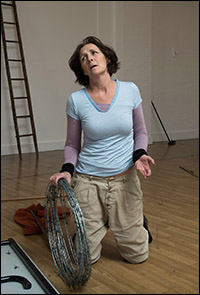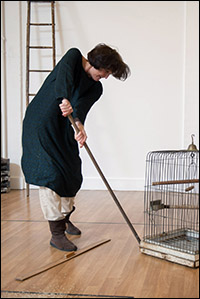
*
"It's not every day you get asked to play the Virgin Mary," Fiona Shaw says.
Shaw is talking about her role in the world-premiere stage version of Colm Tóibín's 2012 novella, The Testament of Mary, now a one-woman play at the Walter Kerr Theatre.
A native of County Cork, Ireland, Shaw is considered one of the finest actresses around today. She has won four Olivier Awards in London, and was nominated for a Tony in 2003 for her title performance in Medea. New Yorkers also know her for her one-woman version of T.S. Eliot's The Waste Land, which came to the city in 1996 at the Liberty Theatre on West 42nd Street, and her portrayal of Winnie in Samuel Beckett's Happy Days, at the Brooklyn Academy of Music in 2008. Both won rousing critical cheers. All three were directed by Deborah Warner, her collaborator on at least 13 productions, including The Testament of Mary.
Shaw is perhaps more widely known as Harry Potter's annoying movie aunt, Petunia Dursley, and as Marnie Stonebrook in HBO's "True Blood." Tóibín is a prize-winning Irish novelist whose highly praised works include "The Master" and "Brooklyn." The lead producer is the Tony, Oscar, Emmy and Grammy award-winning Scott Rudin, who was a co-producer of Medea. An earlier stage version of the current play, called Testament, was performed by Tony winner Marie Mullen (The Beauty Queen of Leenane) in 2011 at the Dublin Theatre Festival. That version led to the novella, which led to the current production.
| |
 |
|
| Shaw in rehearsal | ||
| Photo by Hugo Glendinning |
This Mary is living away from Jerusalem, some years after Jesus' crucifixion, in the major Roman city of Ephesus, in what is now Turkey — "she lived out her days in a distant place away from home," Shaw says. "She is in exile."
But, Shaw says, "theatre is an imaginative frame, so the play takes place now. The story is in many people's minds now — 2,000 years after the events, the story continues. And like all stories, it has embellishments — different colors, different aspects. So it is going on now. I went last week to see the Piero Della Francesa exhibit at the Frick Collection. In the 15th century, they painted the Virgin as a 15th-century woman. So in this play, you meet her as a 21st-century mother. But the events refer to a time when the Romans did crucify their dissidents."
And this Mary controversially rejects the idea, pushed on her by her son's followers, that her son was the Son of God, and that he died to save the world.
"In Colm's story," Shaw says, "she dwells on her memory of the event. Her argument is, no one wants to hear her memory of the event because it doesn't coincide with the elevated memory his followers would like her to have." The differences are "probably true of all memory, of all people's stories, even of families. People in families have different memories of their childhoods — some say it was a happy house, some say it wasn't."
| |
 |
|
| Shaw in rehearsal | ||
| Photo by Hugo Glendinning |
The play "is not lampooning" the beliefs, she says. "It's running on a track imaginatively. It's not revisionism." It's not saying that the events of the novel are "what really happened. It's saying, 'Let's pretend this is what really happened.' That's the nature of imagination, literature and theatre. It's saying, 'What if?' There's Shakespeare's great line, there's 'much virtue in if' — if she was there. I think what Colm has discovered is a woman who, if she was there, found it unbearable. And that's a very reasonable notion. Added to which, there's very little about her in the New Testament — either they didn't want her story or it was forgotten, so Colm tells an imaginative version of it."
The New Testament, of course, "continues," no matter what Tóibín has written, she says. "People can go on believing in it, can go on following it. Colm's not trying to say don't follow it. He's saying, what if this story happened? I think it would be naïve for any Catholic or Christian not to realize that the story [of Jesus] has been built, shifted, translated, pushed, pulled over 2,000 years. It was itself a revisionist text. There was probably a much more female church in the early church, but that got absolutely ironed out."
The New Testament, she says, "sits in people's hearts as the fundamental basis from which they can contemplate reality and redemption. And I don't think that the play is trying to counter that. It's about a woman, a mother, who believed her son was her son and could not know that the meaning of his life would be so taken by others, revised and written by others. Which is what happened. She was not there for the Resurrection. Who knows what she thought about it? What was the Resurrection? They saw him. People do see people after they've died. They do feel they've seen them. Ordinary people who are not religious have that experience too."
| |
 |
|
| Shaw in rehearsal | ||
| Photo by Hugo Glendinning |
She continues, "Religion is about people. ...I think this story fleshes out the people. So I'm thrilled by it. I wish I had heard this story when I was a child. It's much more exciting than the rather arid liturgy that we were offered in which they were very far away from us, wearing strange, floaty costumes and speaking in a very formal 'thee' and 'thou' language."
Shaw and Warner first worked together in 1988, a quarter century ago. What is it that keeps bringing them back together? "We both are very ambitious for what the theatre is," Shaw says. "We seem to be interested in finding a premise that's quite high, or a subject that's quite big. My imagination is rather free-roaming and sometimes slightly wild. She has this phenomenal capacity to organize extraordinary things. She also has this brilliant ability to allow the ordinary to be poetic. She helps me to hone that, and also to make the poetic ordinary. Which is very important, so people feel they belong to the event. She has a huge visual sense, so I always feel I'm being presented beautifully, so I concentrate on the world of the interior mind, to communicate or make the audience see what I'd like them to see in my mind. And she enhances that."
Shaw and Warner usually hone their work at theatre festivals and elsewhere before bringing it to New York. But Mary is different — the work at Broadway's Walter Kerr is for them a world premiere. Why did they decide to take the big leap here? "There's only two words to answer — Scott Rudin. He is an incredibly brave, artistic man who is a rare producer. He stands remarkably among his generation. He is a Renaissance man who is really putting his powers, his views and his artistic sensibility to very good use. He clearly knows how to make things happen. It's daring and brave. And I suppose all we are doing is agreeing to go along with his daring and to allow Broadway to be a place of experiment and discovery. And I think it's very nice for the New York audience — and we need them to be nice to us — to play along and say, yes, this is a new play, this is a new sort of play, this is a very explosive subject. And you could wait and see if it's a success in Paris and London, or you could dare to do it in the middle of New York. So I'm very excited about that."
What's coming up for Shaw after Mary? "I'm going to direct Benjamin Britten's opera The Rape of Lucretia for Glyndebourne in the autumn." And then, in December, she will perform Samuel Taylor Coleridge's poem The Rime of the Ancient Mariner at the Brooklyn Academy of Music. Is there anything she hasn't done onstage that she would still like to do? "I'd like to play Virginia Woolf. And Cleopatra. They're very different people. I like to explore female characters who make the limitations of your life blur because their lives are bigger. That's the great pleasure of playing big, iconic characters. Because you get to see, to pretend, to view, to absorb and to learn about a world beyond your own world. That's the pleasure of it."
She smiles. "And the rest is hard work."




































